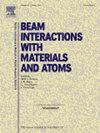Development of a forward Monte Carlo based weight-window generator using the history-counter function in PHITS
IF 1.4
3区 物理与天体物理
Q3 INSTRUMENTS & INSTRUMENTATION
Nuclear Instruments & Methods in Physics Research Section B-beam Interactions With Materials and Atoms
Pub Date : 2024-09-26
DOI:10.1016/j.nimb.2024.165535
引用次数: 0
Abstract
Appropriate use of the variance reduction techniques such as weight-windows are indispensable for effectively designing the radiation shielding based on the Monte Carlo simulation. In this study, we developed a new algorithm of weight-window generator (WWG) relying solely on forward Monte Carlo simulation and implemented it into the Particle and Heavy Ion Transport code System (PHITS). Our new algorithm leverages a PHITS-specific function called the “history counter”, which serves as an event logger that can be arbitrarily defined by users. The performance of the new WWG was investigated by conducting benchmark simulations for both idealized and practical shielding calculations. The results of the benchmark simulations suggested that our new algorithm can reduce the computational time by up to an order of magnitude. With this new feature, PHITS has become further suitable for the shielding calculations against high-energy radiations even when their evaluated cross-section data are unavailable.
利用 PHITS 的历史计数器功能开发基于前向蒙特卡罗的权重窗口生成器
要在蒙特卡罗模拟的基础上有效地设计辐射屏蔽,就必须适当使用权重窗口等降低方差的技术。在这项研究中,我们开发了一种完全依赖于正向蒙特卡罗模拟的权重窗口生成器(WWG)新算法,并将其应用于粒子和重离子输运代码系统(PHITS)。我们的新算法利用了 PHITS 特有的 "历史计数器 "功能,该功能可作为用户任意定义的事件记录器。通过对理想化和实际屏蔽计算进行基准模拟,研究了新 WWG 的性能。基准模拟的结果表明,我们的新算法最多可将计算时间缩短一个数量级。有了这一新功能,PHITS 已进一步适用于高能辐射的屏蔽计算,即使在无法获得其评估截面数据的情况下也是如此。
本文章由计算机程序翻译,如有差异,请以英文原文为准。
求助全文
约1分钟内获得全文
求助全文
来源期刊
CiteScore
2.80
自引率
7.70%
发文量
231
审稿时长
1.9 months
期刊介绍:
Section B of Nuclear Instruments and Methods in Physics Research covers all aspects of the interaction of energetic beams with atoms, molecules and aggregate forms of matter. This includes ion beam analysis and ion beam modification of materials as well as basic data of importance for these studies. Topics of general interest include: atomic collisions in solids, particle channelling, all aspects of collision cascades, the modification of materials by energetic beams, ion implantation, irradiation - induced changes in materials, the physics and chemistry of beam interactions and the analysis of materials by all forms of energetic radiation. Modification by ion, laser and electron beams for the study of electronic materials, metals, ceramics, insulators, polymers and other important and new materials systems are included. Related studies, such as the application of ion beam analysis to biological, archaeological and geological samples as well as applications to solve problems in planetary science are also welcome. Energetic beams of interest include atomic and molecular ions, neutrons, positrons and muons, plasmas directed at surfaces, electron and photon beams, including laser treated surfaces and studies of solids by photon radiation from rotating anodes, synchrotrons, etc. In addition, the interaction between various forms of radiation and radiation-induced deposition processes are relevant.

 求助内容:
求助内容: 应助结果提醒方式:
应助结果提醒方式:


